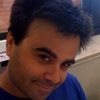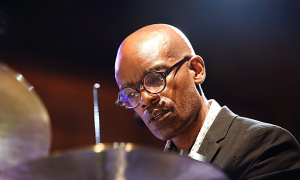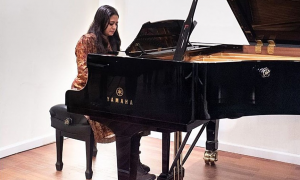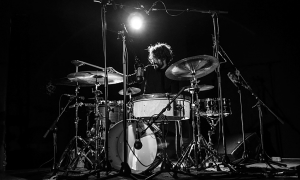Home » Jazz Articles » Under the Radar » Experimentalists: Talking with Adam Berenson, Dana Jesse...
Experimentalists: Talking with Adam Berenson, Dana Jessen, and Abdul Moimême
When working with more unconventional methods or techniques, is it more difficult to instill emotional levers in the music?
AB: "Not at all. The musician's job is to make everything as musical (and that almost always incorporates "emotion') as possible. John Coltrane loved McCoy Tyner's playing because he knew that any idea that he might throw out there (no matter how strange) would be 'seriously' and instantly processed by McCoy, and would, in turn, alter the ripples of music emitted from Tyner's playing. One can recognize a great musician at the earliest age because even the way—say—a five-year-old plays a 5-note scale, it has 'music' in it. In Schumann's "Notes to Young Musicians" he rightly proclaims that one is never 'practicing' music. Every time you play anything you should imbue it with musicality, 'performance,' emotion (if appropriate), and sensitivity, even if one is playing it much slower than it is supposed to be played, for example. As many musical ingredients as possible should go into the learning of a piece, as soon as possible. The reasons for this are multiple."DJ: "It sometimes can be. But that becomes the challenge as a composer and improviser-how to create a moving and musical output with these techniques. My most favorite performances are those where I can see the raw emotion emitted from the performer. For me, maintaining an emotional outlet in the music is necessary."
AM: "For me, it's quite the contrary, it's easier, but I imagine that will depend on the individual artist."
Are you trying to suggest a certain atmosphere with your compositions?
AB: "You might say that all compositions— by anybody— are expressing an atmosphere of some kind. However— almost always— how one might characterize the resultant 'atmosphere' only becomes apparent in retrospect."In general, do you think that performing experimental music in a live setting is more challenging?
AB: "Unfortunately, I don't perform very often, so I can't really comment. It's difficult enough to perform 'conventional' music without having to pay to perform. However, I would speculate that much of this would depend upon the receptivity and the attitude of the audience. Again, alas, all music performance's affectivity depends to a large extent upon the attitude of the audience, just as any band music would depend upon the mood of the performers, their connection on the particular evening, and the attitude of the audience. I wonder if our current zeitgeist and attention span would allow for challenging music to be performed more frequently? Perhaps there are some small spots in NYC where this is thriving that I know nothing of."DJ: "I think that all live music has to be convincing and engaging. For me, many of my audiences may not have heard some of the techniques and sounds that I will present. Therefore, I have to be conscious of how I engage them with the music and present it in a way that asserts value around what I am playing."
AM: "In Free Improvisation that's what it's all about. Being in a specific setting and communing directly with the public is usually inspiring. This doesn't mean that the 'aseptic' environment of a studio can't also be challenging, as being in an updated science laboratory. In the studio, things may be less spontaneous and more analytical, which can be interesting. Presently, I mostly enjoy 'site-specific' performances. Which doesn't mean I won't go into a studio soon."
The effect you have realized in a recording would likely be experienced in different ways by different listeners. When you listen to your own work, after the fact, does it also affect you in unexpected ways?
AB: "This is perhaps a neurological topic all its own. One definitely hears differently— physiologically— when one listens to music that one is not playing. Of course, if one is overdubbing or if there are live electronics (perhaps being added by the engineer) during a performance, it can only be in retrospect that one can really process what has occurred. It's usually a wonderful time when one listens back to a take. Usually, I know if something has worked while I'm creating it, and when I listen back, I can decide very quickly if I will use it or not. My instincts are very sharp in this domain. I also become very sensitive to everything in the aural picture, and I can hear where there are very, perhaps distant, technical issues that will need repair in post-production—if it's possible. Some of the percussion on the "jnana" album did not work at all, and we had to remove it entirely. Interestingly, we couldn't remove the percussion sounds which had bled into the other mics, and so a large part of that album has the texture of distant percussion 'bleed-through,' which created something totally unforeseen and (for me) quite new and interesting. So, there can (and often are) many happy accidents that occur both technically (in terms of the technology being employed) and, of course, musically. On the contrary, sometimes things which one might have thought worked well, can, occasionally, be ineffectual. For myself, this is uncommon.DJ: "It's interesting to hear recordings of my own improvisations. Mostly because the recording captures a snapshot of who I was at that time. It allows me to reflect on what I found interesting (musically) back then compared to what I may be doing now. As improvisers, we are continuously evolving, so recordings are an interesting snapshot of an earlier version of yourself. It is nice to hear recordings after some time away. When recordings are created, you are so enveloped in the music and planning/organizing. It's always nice to listen back after a time with fresh ears."
AM: "There is always the 'day after' test or the 'week after,' when you've distanced yourself from the material and can approach it with objectivity. That's always desirable if one is considering releasing material. After some time has elapsed, one's perception of the results is usually unexpected, for better or worse. Objectivity doesn't annul sensitivity; quite the contrary. Objectivity is a necessary precondition to devise the 'theatrical' dimension, the aural mise-en-scène, of a recording mix."
A listener's ears are not hard-wired to anticipate a logical sequence of sound with some experimental music. Is there an element of mystery in how an unconventional piece plays out?
AB: "Again, there should be an element of mystery in any piece of music, or one is likely to not return to it. In Mozart piano concertos (for example) often, the composer does something very conventional and expected, formally, and for some very mysterious reason, it's shocking. This is very hard to explain. We are all hardwired to find patterns and 'make meaning' out of our experiences in life and I'm sure we are all attempting to do this whenever we hear anything that we are supposed to pay attention to, as it is construed as 'music.' If there isn't some 'tangible' or cohesive element to a sonic event, perhaps it isn't 'art' or 'music.' Music is inherently meaningless, and so we need repetition (of some kind; in some domain) in order to make sense of it in some fashion. Back in the days of 'sonata' form, the opening A section was usually repeated, so that when the 'development' occurred, one was aware of what was being 'developed.' (In the classical era, symmetry also played a role in this necessity.)"AM: "That's the 'million dollar question.' Surely there must be, but that also applies to 'conventional' music. Pianist Daniel Barenboim's explanation of how to create the 'illusion' of a crescendo, with a single piano chord, strikes me as relevant. He tells us, "You must imagine the piano is doing the crescendo and then, when you play the next note, [it] has to be the result of your imaginary crescendo," you must want it to happen."
"As a personal anecdote, in a recent concert, playing alongside saxophonist Albeto Cirera and double bassist Alvaro Rosso, I was sustaining a long continuous note and at a given point decided there must be a crescendo. But I didn't play a crescendo, I merely kept the note sustained a fraction longer, as previously suggested and only imagined the crescendo. To my amazement, Albert and Alvaro produced a perfectly synchronized crescendo as I was imaging it. Was it telepathy? I believe not! What I believe in is playing with musicians that really listen and know, at any given moment, what the music begs. There's plenty of mystery in that!"
Adam Berenson sums up the conundrum of musical experimentation as a conscious attempt to fuse science and art in an accessible way. "Ever since—at least—the Industrial Revolution, when science and technology were beginning to infiltrate everyday life, artists (really by necessity) had to respond to this. Here I'm thinking of Charles Ives, George Antheil, and later Varese, but there are probably many which one could name. Even Haydn (with his poetic rendering of 'clocks') and Beethoven (with his mimicking of the metronome) were reacting to technology. And, they were doing so in an accessible (yet structurally necessary and justified) way. Perhaps it's impossible to disconnect science and technology from music, even if their relationship isn't perceived in an overt way."
Selected Discography
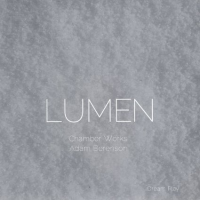 Adam Berenson: Lumen
Adam Berenson: Lumen(Dream Play Records, 2015)
This double-CD offers a sprawling collection of string quartet compositions, multiple jazz styles, electronica, blues and noise all of which Berenson sees as related to a consistent creative process and all falling comfortably under the umbrella of "chamber music" in the composer's mind. It's hard to argue with his hypothesis when this enormous collection flows seamlessly, logically and beautifully from one exploratory piece to the next, breathing, expanding and contracting like a living entity.
Lumen features almost as many personnel variations as styles of music. Bassist Scott Barnum has played with saxophonist Dave Liebman, pianists and Bill Carrothers and—importantly, given the content here—Ran Blake. Drummer Bob Moses knows something about working with bassists having sat in with Charles Mingus at twelve. He went on to work with saxophonist Rahsaan Roland Kirk, Gary Burton and Pat Metheny among other notable figures. Philadelphia area percussionist Bill Marconi—with a diverse jazz background—contributes both in the rhythm section and with electronics. The very avant-garde JACK Quartet and an additional group of string musicians participate in the two string quartet pieces.
A gong, bells, chimes and other percussion usher in the spellbinding duo performance on "Transpersonal." The piece sets up the first of four sonic explorations in the non-sequential versions of "Jnana" which—along with "Spooky Action at a Distance"—represent the most experimental of the pieces on Lumen. Employing prepared piano and electronics, Berenson explores a range of tones, sonorities and genres from noise to neo-classical. His solo piano pieces, such as "Stars 1" and "Yasujiro Ozu" offer respite from the more intense and unorthodox pieces but still encompass a tension between structure and invention.
The jazz trio utilizes an irregular approach resulting in multifaceted sound, by turns forceful and—only occasionally—melodious, propelled by Barnum and Moses (or Marconi) and Berenson's impressive range of expressive character. The avant-garde "Emotional Idiot," "Ricercar (For Sven Nykvist)" and "Very Soon Mankind Will No Longer Be a Useless Passion (Broadway Melody of 1996)" present a variety of textures and modulating tempos within complex pieces. More melodic are the third-stream like "Rainer Maria Rilke," the appropriately childlike "A Little Boy Opened a Window" and the bluesy "Ingrid Thulin." Each of the two discs concludes with a string quartet, the first "String Quartet #3" featuring the JACK Quartet is every bit as unorthodox as the most experimental pieces performed by the jazz group. At over fifteen minutes in length, it is sometimes as quiet as a whisper and at others, agitated and noisy. The five movement "String Quartet #1"—performed live and recorded in 1997— closes the second disc and is more traditional, often beautiful compared to the adventurous and eccentric closing of the first disc.
Lumen is an ambitious and uncompromising collection whose diversity never trips it up. Berenson's cerebral process and understated—but unmistakably—dramatic sense of time and placement bring his vision into sharp relief. From free jazz to classical dance influences, he manages a balance between austere and radical, not playing into the hand of either, but producing something that feels organic. Lumen is an outstanding artistic creation from a limitless composer.
Track Listing: Disc 1: Transpersonal; Jnana, Pt. 10; Late 20th Century Stomp; Emotional Idiot; Prose Surrealism;Very Soon Mankind Will No Longer Be a Useless Passion (Broadway Melody of 1996); Jnana, Pt. 13; Rainer Maria Rilke; Ricercar (For Sven Nykvist); ... Was Near the Black Plague..; A Little Boy Opened a Window 3; ... Searching... Everywhere..; Dithyramb; Jnana, Pt. 8; Treaty of Dancing Rabbit Creek; String Quartet #3. Disc 2: "I"; Respectable People; Stars 1; The Adytum; Tickled to Death; Jnana, Pt. 18; Ingrid Thulin; Through This Stillness; Yasujiro Ozu; Spooky Action at a Distance; String Quartet #1: Pt. I; String Quartet #1: Pt. II; String Quartet #1: Pt. III; String Quartet #1:Pt. IV; String Quartet #1: Pt. V.
Personnel: Adam Berenson: piano, synthesizer, live electronics, and composition; Scott Barnum: double-bass, prepared double bass, live electronics; Bill Marconi: percussion, live electronics; Bob Moses: drums; JACK Quartet: John Pickford Richards: viola; Ari Streisfeld: violin; Christopher Otto: violin; Kevin McFarland: cello; Yukako Funahashi: violin; Annete Chan: violins; Ilana Schroeder: viola; Sigurgeir Agnarsson, cello.
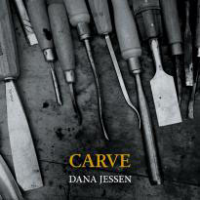 Dana Jessen: Carve
Dana Jessen: Carve(Innova Recordings, 2017)
Jessen is a busy contributor in the chamber music genre, as well a soloist and impressive improviser. Her Carve opens with "Of an Implacable Subtraction," a darkly melancholy piece from the innovative composer Paula Matthusen, its odd meters and multiple layers adding an unexpected fullness to the instrumentation. At times, "Fireflies in Winter" sounds more like foghorns in the harbor but as it builds, Jessen's vision comes to fruition with remarkable clarity. That depth is replaced with an emphasis on technique, on the brief title track which features Jessen playing the reed only. High pitched and oddly organic, it is the top of the roller-coaster to the subsequent "Cadenza & Degradation." The title track is presented in three additional variations including bassoon, without reed and bassoon with teeth. At more than thirteen minutes in length, the Kyle Bruckmann composition plays out in the lower register of the bassoon; a dark, eerie melody augmented by lacey effects floating almost out of earshot and Jessen providing her own bass effects. The bassoonist later rivals Peter Brötzmann's tenor with an unanticipated and menacing growl.
For those who appreciate unusual applications of familiar instruments—such as the accordion techniques of Pauline Oliveros or the solo soprano saxophone experiments of Sam Newsome— there is that element of surprising improvisation in Jessen's work. Far from being a novelty recording, Carve is an eye-opening experience in the ways of an underutilized instrument. Jessen's virtuosity, and selection for this program, make this an intriguing listening experience.
Track Listing: Of an Implacable Subtraction; Carve (Without Reed); Points Against Fields (Tombeau de Bernard Parmegiani); Carve (With Teeth); Fireflies in Winter; Carve (Only Reed); Carve (Postlude).
Personnel: Dana Jessen: bassoon, electronics.
 Abdul Moimeme: Exosphere
Abdul Moimeme: Exosphere(Creative Sources Recordings, 2017)
Exosphere is the follow up to Mekhaanu—La Forêt des Mécanismes Sauvages (Insubordinations Netlabel, 2013) and like that album, Exosphere features Moimême on his two home-made electric guitars, enhancers and assorted sound devices. The sole track is the forty-one-minute title track. Much of what Moimême does here is a product of reverberation and what he does with that reverberation is remarkable. Listen at the sixteen-minute mark in and you'll hear something akin to a muted blast of trumpets. Further in there is the jangle of chimes and later still the approximation of piano keys. All these peripheral effects lie within a broader universe indeterminate in nature. Rarely does Moimême incorporate a guitar-like dynamic—he plays his two custom guitars simultaneously using an electronic bow, amplified through a pre-amp and two speakers.
Moimême has developed a method of making reverberation into an instrument that can stand alone. As a narrative Exosphere is both allegorical and conversant, always leading to another destination but never being obvious about where Moimême intends to set down. The artist travels through backdrops only familiar enough to invite a double-take, a bit of misperception about the source of a sound or the direction it is coming from. There is some intangible quality to Moimême's composition that makes one want to listen repeatedly. Exosphere is an extraordinarily unique and highly enjoyable album.
Track Listing: Exosphere.
Personnel: Abdul Moimême: prepared electric guitars, devices.
Photo credit: Nuno Martins
< Previous
SPAZA
Next >
As A River
Comments
About Adam Berenson
Instrument: Synthesizer
Related Articles | Concerts | Albums | Photos | Similar ToTags
Under the Radar
Karl Ackermann
Hubert Laws
Ornette Coleman
Alice Coltrane
The Bad Plus
Bix Beiderbecke
duke ellington
Branford Marsalis
Charlie Parker
Pauline Oliveros
Àine O'Dwyer
Susana Santos Silva
Rob Mazurek
Darcy James Argue
Adam Berenson
Paul Bley
cecil mcbee
Frank Zappa
Dana Jessen
Satoko Fujii
anthony braxton
Abdul Moimême
Albert Ayler
Joe Maneri
Anthony Coleman
Joe Morris
Frank Gratkowski
Art Ensemble of Chicago
Roscoe Mitchell
ICP Orchestra
Meredith Monk
Scott Barnum
Dave Liebman
Bill Carrothers
Ran Blake
Charles Mingus
Roland Kirk
Gary Burton
pat metheny
Peter Brotzmann
Sam Newsome
For the Love of Jazz
 All About Jazz has been a pillar of jazz since 1995, championing it as an art form and, more importantly, supporting the musicians who create it. Our enduring commitment has made "AAJ" one of the most culturally important websites of its kind, read by hundreds of thousands of fans, musicians and industry figures every month.
All About Jazz has been a pillar of jazz since 1995, championing it as an art form and, more importantly, supporting the musicians who create it. Our enduring commitment has made "AAJ" one of the most culturally important websites of its kind, read by hundreds of thousands of fans, musicians and industry figures every month.

